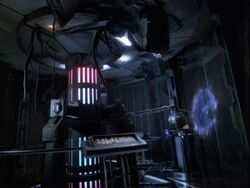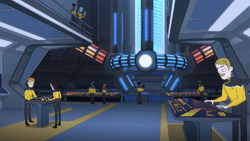The gravimetric field displacement manifold, commonly known as the warp reactor. Just think of it as a great big engine but instead of using electricity or chemical fuel it runs on antimatter.Charles Tucker III
Warp core, or warp core reactor, was the common designation for the main energy reactor powering the propulsion system on warp-capable starships. During the 22nd century, warp reactors aboard NX-class starships were technically known as the "gravimetric field displacement manifold". (ENT: "Cold Front") A less common name for this core was antimatter reactor core. (TNG: "Booby Trap", display graphic)
The first Terran warp core was invented by Zefram Cochrane in 2061 and used in Humanity's first warp-capable vessel, the Phoenix, in 2063. The Phoenix's first flight on April 5th, 2063 was detected by a passing Vulcan survey ship, the T'Plana-Hath, who decided to initiate the first open contact between Humans and another species. The event was later considered a defining moment in Human history and celebrated as First Contact Day. (Star Trek: First Contact; VOY: "Friendship One", "Homestead")

On Federation starships, the warp core usually consisted of a matter/antimatter reaction assembly (M/ARA) utilizing deuterium and antideuterium reacting in a dilithium crystal matrix, producing a maximum output of four thousand teradynes per second. (VOY: "Drone")
Twenty-second century warp cores were designed as oblong cylinders connected by pylon conduits directly into the warp nacelles. (ENT: "Broken Bow")
Twenty-third century warp cores varied in design, but still had the matter-antimatter reaction occur horizontally until at least 2269. On some ships such as the Crossfield and Constitution-classes, the warp core was not located in main engineering and was instead located in the dilithium energizer room, separate from main engineering (ENT: "In a Mirror, Darkly, Part II"; TOS: "That Which Survives", "The Alternative Factor")
In 2269, Federation warp cores had gained a radical upgrade. A new vertical segment was added to the dilithium crystal converter in main engineering, marking the transition to a new age of Starfleet warp core design. This new component allowed for increased power generation, and a large upgrade of the older horizontal mixing warp cores. (Star Trek: The Animated Series)
By 2270, most Federation warp cores were redesigned to consist of a large vertical warp core unit, doing away with the older obsolete horizontal cores. Located in the secondary hull, the matter and antimatter reaction plasma from the intermix chamber traveled the core through vertical conduits into the dilithium crystal converter, or main energizer as it was then called, (Star Trek II: The Wrath of Khan) with the resulting warp plasma energy directed to the nacelles through horizontal conduits leading out from the rear of the core. This advancement allowed for speeds of up to warp factor 12 on the old scale. At this point the warp speed scale was revised for TNG to allow for higher warp speeds. (Star Trek: The Motion Picture)
Of the original Constitution-class warp core, only the dilithium crystal converter assembly and the warp engine plasma conduits were ever seen in Star Trek: The Original Series. The first season had a dilithium crystal energizer room only seen in "The Alternative Factor". It is likely the predecessor to the dilithium crystal converter assembly added to Main Engineering in seasons two and three. The tech evolved over the course of the series. The engine room was modified after season one to include the dilithium crystal converter, two round nodules with the crystal chamber in between placed in the center of Main Engineering. During the second season this prop was not used as the dilithium crystal converter since no second season episodes called for it. The third season utilized the prop extensively as the dilithium crystal converter and the crystal chamber access was added to the prop for the episode "Elaan of Troyius" where it made its first appearance. This may be seen as a new advancement the previously seen energizer since it was at this point in the the series the top emergency speed became warp 9. There were also power (warp plasma) conduits which were two rows of five tall white tubes with pulsating red light behind a safety grate at the back of the main engine room. This was seen throughout the series' three seasons and used as a major component to the ship power systems. When Doug Drexler was called to design the detailed schematics of a Constitution-class starship, he included a vertical core from the dilithium crystal assembly intersecting a horizontal core that ran two decks below main engineering. This area was the matter/antimatter integrator and injectors utilizing an intermix chamber for the reaction to occur (what was first referred to as a warp core in the third season of TNG in "The Best of Both Worlds"). The resulting plasma, energized by the dilithium crystal converter assembly into warp plasma, was transferred to the warp engines through the warp plasma conduits. [1](X) The Drexler schematic made a prominent appearance on screen in ENT: "In a Mirror, Darkly, Part II".
Star Trek: The Animated Series also featured a vertical component of the warp core that extended from the dilithium crystal assembly. This was a logical progression of the technology to that seen in Star Trek: The Motion Picture.
As evidenced by the second draft script of ENT: "Broken Bow", the 22nd century warp core aboard an NX-class starship was originally designed to be vertical and extend through a deck, with a top which was high. A series of levers was at the bottom of the towering engine, and "pulsing pillar[s] of plasma" occasionally rose up through the warp core. Drawing inspiration from the engine of the Constitution-class USS Enterprise in Star Trek: The Motion Picture and motivated by wanting to clearly show the NX-class was a relatively early ship, Production Designer Herman Zimmerman suggested that the NX-class engine be of a horizontal configuration, an idea that was quickly approved by series co-creators and Executive Producers Rick Berman and Brannon Braga. (Star Trek: Communicator issue 135, p. 64; Star Trek: The Magazine Volume 2, Issue 7, p. 52) Changing the engine's orientation made the warp core look obviously different from its equivalents in later Star Trek chronology, warp cores that had typically been vertically positioned. (Star Trek: The Magazine Volume 2, Issue 7, p. 52) The "Broken Bow" script was changed to reflect the alteration and, in the revised final draft of the script, the warp core was described as extending "horizontally across the room." [2] Zimmerman noted, "We talked of a honeycomb design with multiple push and pull rods, accessible through open-able doors." (Broken Bow, paperback ed., p. 269) However, the design of the warp core fell into place very quickly. Additionally, because it was to be represented as an engine which required a great deal of maintenance, the warp core was designed to incorporate enough controls and access panels that the crew could busy themselves with working on it. (Star Trek: The Magazine Volume 2, Issue 7, p. 52) Concerning how the warp core turned out, Zimmerman remarked, "It doesn't look like you can't understand it or that it wouldn't break down if all the components weren't working perfectly. So, it's a more realistic propulsion system than the fantastic propulsion system." (Broken Bow, paperback ed., p. 269)
As a safety precaution, the core could usually be physically ejected from the ship, should an event such as a catastrophic containment failure of the matter-antimatter reaction occur that could not be corrected. There were also some tactical uses for ejecting and detonating a core on purpose. The detonation could, for example, be used to neutralize the cascade of a subspace tear or to push a ship away from the gravity well of a black hole. (TOS: "That Which Survives"; TNG: "Cause And Effect", "All Good Things..."; VOY: "Cathexis", "Day of Honor", "Renaissance Man"; Star Trek: Insurrection; Star Trek; LD: "The Stars At Night")
Antimatter containment was achieved through the use of magnetic fields, which guided and directed the antimatter through the antimatter integrator to injector coils, which precisely compressed and streamed the antimatter into the form which entered the intermix chamber. Deuterium, stored in the ship or attracted by the Bussard collectors, was funneled in a stream from the opposite deuterium injector. The resulting energy plasma molecules entered the lattice matrix of the crystallized dilithium chamber, reacting within it and releasing a tuned energy stream in the form of electro-plasma, a highly energetic form of plasma. The electro-plasma was carried by magnetic plasma conduits throughout the power transfer system. In the Federation power transfer grid, this was the electro-plasma distribution network, comprised of EPS conduits and EPS taps. The most energized stream created was the warp plasma, which exited in twin power transfer conduits connected to the warp nacelles. (ENT: "Cold Front", "These Are the Voyages..."; Star Trek: Insurrection)
In Star Trek: The Original Series, there were ten tall warp plasma conduits to the warp nacelles (two rows of five) at the rear of main engineering. All later series had the twin configuration, one for each nacelle or warp engine.
By the 24th century the dilithium crystal converter and matrix was replaced by a dilithium chamber matrix and articulation frame housed directly inside the matter-antimatter intermix chamber in a vertical warp core. (TNG: "The Best of Both Worlds", "Relics")
Dilithium crystals were also used in Klingon warp reactions on the 23rd century to generate energy at sufficient levels to enable warp flight. In the late 24th century, Klingon reactors used a tritium intermix, a feature not included in Federation and Romulan ships of the same era. (DS9: "When It Rains...") On Romulan starships, a completely different approach was used; an artificial quantum singularity in the warp core harnessed the energy necessary to power warp flight. (TNG: "Timescape")
Warp cores on starships left resonance traces, allowing for the ability to track vessels. (VOY: "Caretaker")
A warp core could be towed at warp using a tractor beam if calibrated properly. (VOY: "Day of Honor", "Renaissance Man")
When a warp core went offline, deuterium was a vital fuel to support basic functions of a ship's auxiliary fusion reactors and impulse drive. Warp cores from shuttlecraft and shuttlepods could augment power, if necessary. (VOY: "The Void")
Warp cores emitted a thrumming sound, audible through much of the ship, that some Humanoids found soothing, gentle, or otherwise pleasant. (LD: "Terminal Provocations"; SNW: "Spock Amok", "Those Old Scientists")
Gallery


(alternate reality, 2259)









(alternate reality, 2258)

(alternate reality, 2259)







